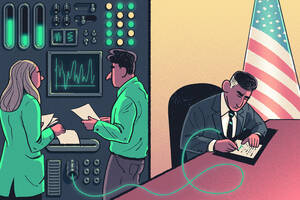Still, taxes don’t always achieve their desired outcomes—and studying their impact can lead to some surprising conclusions. Here’s a roundup of some of our favorite articles on what taxes can (and can’t) do.
A progressive tax policy, where the highest earners pay the most, can change the careers that people choose to pursue, according to research from Kellogg’s Charlie Nathanson.
By shifting marginal tax rates, he explains, the take-home pay associated with certain income levels can vary—often quite drastically. This, in turn, can make different professions more or less appealing. When marginal tax rates are high, professions that may not pay well but offer a lot of benefits to society—think teachers or health aids—become more desirable.
But according to Nathanson, the benefits of a progressive income tax over a flat tax on collective well-being aren’t huge: only about one percent. That’s because it’s a “blunt tool.” A more targeted approach, such as subsidizing specific professions, would have a bigger impact.
Soda taxes are a relatively recent spin on the quintessential “sin tax,” where the goal is to raise revenue while discouraging an unhealthy behavior, in this case drinking sweetened beverages. But do soda taxes work?
A 2021 study by Kellogg’s Anna Tuchman analyzed the implementation of a soda tax in Philadelphia. The research team found that, after the tax went into effect, purchases of sweetened beverages inside city limits dropped by 46 percent. However, purchases of these beverages at stores outside city limits skyrocketed, bringing the overall drop in purchases to just 22 percent.
The researchers also noticed an unintended consequence of the new tax: “Lower-income consumers are taking on more of the tax burden,” says Tuchman. Sales decreased less in lower-income neighborhoods than higher-income ones, perhaps because it was more difficult for low-income residents to travel to the suburbs to do their shopping. Where the soda tax did succeed, however, was in raising money. Philly raised $79 million in its first year.
Local politicians often offer tax credits to investors in early stage startups. The goal is to incentivize angel investors to open their wallets to support local companies, ultimately leading to a broader economic boom.
But an analysis by Kellogg’s Filippo Mezzanotti suggests that, while angel-investor tax credits do increase investment, there are no associated benefits to the economy: the credits do next to nothing to increase local employment, for instance, or the number of startups in the region.
How could this be? Mazzanotti and his colleagues find that the angel investors who tend to take advantage of these tax credits are generally less experienced. On the other hand, professional investors—the ones who are well-practiced at collecting information and screening companies—seemed to barely even notice the new incentive.
“The way these professional investors are thinking is, ‘I’m trying to select the next Google,’” Mezzanotti explains. “‘And if I’m trying to select the next Google, it will be the next Google whether there’s a tax credit or not.’”
Often, local and state governments think that they can boost their economies by offering companies generous tax incentives to move to (or stay in) their area. But according to Kellogg strategy professor Therese McGuire, this is rarely the case.
“It’s essentially a race to the bottom,” she says. “Governors and mayors always feel like they have to play the game, whether or not it makes sense for economic development. It’s like the prisoner’s dilemma.”
Yes, providing tax incentives to some businesses—or for that matter, cutting corporate taxes for all businesses—can have an impact on the margins. Some firms in Illinois may be inclined to move to Indiana, if it is easy for them to tap the same labor pool.
But the truth is often more complicated. After all, companies consider much more than tax rates when deciding where to base their business. And cutting taxes means less revenue to spend on public investment, which does drive growth in local economies, especially when directed toward infrastructure and education. According to an Economic Policy Institute report, investments in public capital contribute significantly to private-sector productivity, with estimated rates of return averaging around 30 percent.
“Every company wants educated workers, a well-functioning transportation system, dependable utilities, and so on. Cities and states that invest in themselves are attractive places to do business,” says McGuire.
OK, this last article isn’t about a tax that’s real. At least not in the U.S. But we included it because it shows just how powerful taxation can be as a strategy for shaping our societies.
Finance professor Sergio Rebelo and colleagues built a mathematical model of the economy that divided the workforce into “routine” work that can be easily automated and nonroutine work that cannot. The researchers then used this model to see how incomes of these two groups will change as automating work becomes less expensive. They found that routine workers will have no choice but to accept lower and lower wages so they can compete with robots, while nonroutine workers will use robots to their advantage, increasing their productivity.
But they also found that robots will never entirely replace routine human labor, as machines will reach the point where they can’t get any cheaper, and wages for routine workers will bottom out at the same level. This scenario is problematic not only for routine laborers (who will have to work for peanuts), but also for nonroutine workers, since the overall economy will be producing less output than it would if everything routine could be automated.
Enter the robot tax! Because robots can be substituted for routine workers, anything that makes robots more expensive will also increase routine workers’ wages. A tax on robots offers an indirect way to tax nonroutine workers and more equitably distribute income in the economy.
Still, a robot tax would have to be pretty high before it began to alleviate inequality. Which is why the researchers ultimately propose a plan that taxes robots but also provides workers with a minimum income payment. This would give workers a safety net, while allowing all routine work to eventually transition to robots, increasing the productivity of the economy.
“You want to get that high level of efficiency—but then you want to redistribute the bounty that comes from technology so that everyone can reap the benefits,” says Rebelo.




